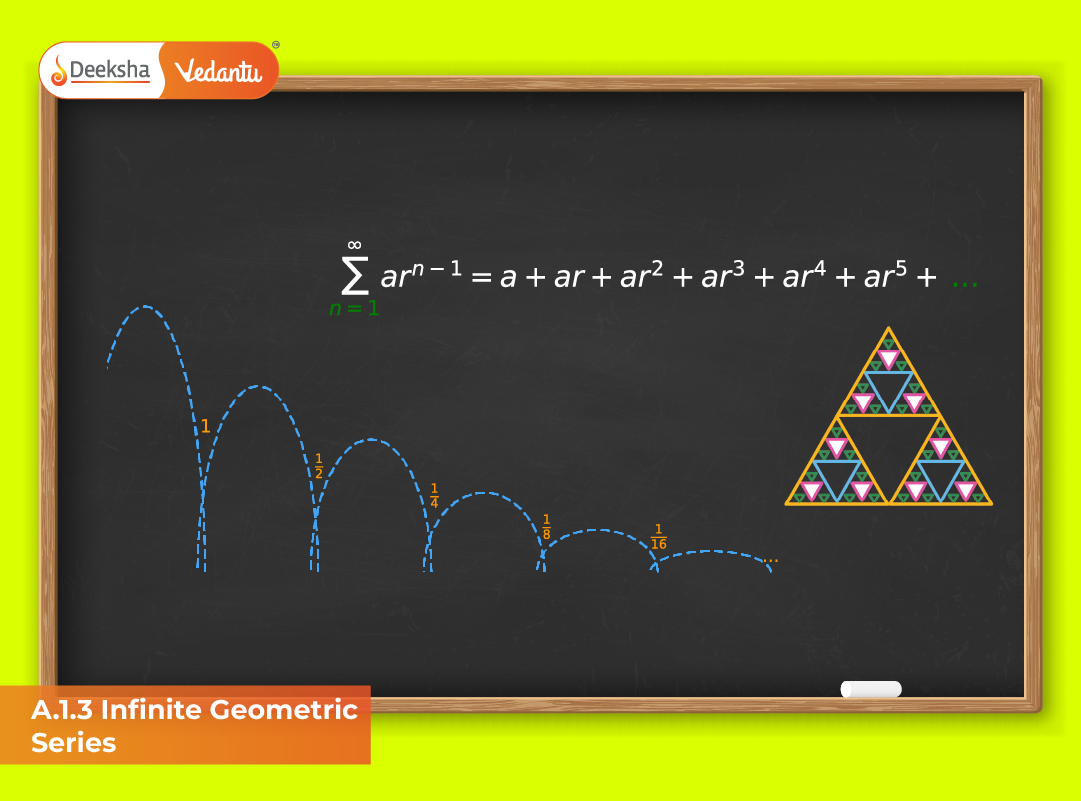
Overview
An Infinite Geometric Series (IGS) is one of the most fascinating and useful mathematical concepts, especially in higher-level competitive exams like JEE Main and JEE Advanced. It bridges the gap between finite algebraic progressions and advanced calculus-based series. Understanding this concept is crucial for mastering summation techniques, limits, and convergence — topics that are directly linked to JEE mathematics and physics problem-solving.
A geometric series is a series in which each term is obtained by multiplying the previous term by a fixed constant, known as the common ratio (r). When the number of terms in such a series tends to infinity, it is called an infinite geometric series.
Definition
If a is the first term and r is the common ratio, then an infinite geometric series is represented as:
S = a + ar + ar² + ar³ + … ∞
Convergence Condition
For the series to have a finite sum, the common ratio must satisfy:
|r| < 1
When |r| < 1, the terms of the series become smaller and smaller as n → ∞, approaching zero.
Formula for Sum of an Infinite Geometric Series
The sum (S) of an infinite geometric series is derived from the finite geometric sum formula:
Sₙ = a × (1 – rⁿ) / (1 – r)
Taking the limit as n → ∞:
S = limₙ→∞ a × (1 – rⁿ) / (1 – r)
Since rⁿ → 0 when |r| < 1, we get:
S = a / (1 – r)
Examples
- Example 1: Find the sum of the infinite series 3 + 1.5 + 0.75 + …
Here, a = 3, r = 1/2
S = 3 / (1 – 1/2) = 6
Result: The sum of the series is 6. - Example 2: Find the sum of 5 + 3 + 1.8 + 1.08 + …
Here, a = 5, r = 0.6
S = 5 / (1 – 0.6) = 12.5
Divergence
If |r| ≥ 1, the terms of the series do not tend to zero, hence the series diverges.
Example: 2 + 4 + 8 + 16 + … diverges because r = 2 > 1.
Applications in JEE
Infinite geometric series are tested in JEE Mains and JEE Advanced under the chapters of Sequences and Series, Binomial Theorem, and even Calculus (in infinite sums and limits). Typical questions involve identifying convergence, finding the sum, or solving functional equations using geometric progression concepts.
Marks Weightage
| Exam | Chapter | Average Weightage | Difficulty Level |
| JEE Main | Sequences & Series | 4 Marks (1 Question) | Easy to Moderate |
| JEE Advanced | Algebra & Series | 4–8 Marks (1–2 Questions) | Moderate |
Derivation from Finite Series
Starting from the finite geometric sum:
Sₙ = a(1 + r + r² + … + rⁿ⁻¹)
Sₙ = a × (1 – rⁿ) / (1 – r)
If |r| < 1, as n → ∞, rⁿ → 0:
S = a / (1 – r)
This forms the foundational proof of convergence in infinite geometric progression.
Graphical Representation
When plotted, the partial sums of a convergent infinite geometric series approach a limiting value asymptotically. For example, if a = 1, r = 0.5, then:
- S₁ = 1
- S₂ = 1.5
- S₃ = 1.75
- S₄ = 1.875
… approaching 2 as the limit.
Advanced Applications
- Mathematical Analysis: Used in convergence tests, power series, and solving infinite sum problems.
- Physics: Applied in optics, mechanics (frictional force modeling), and geometric decay in energy transfer.
- Computer Science: Appears in algorithm analysis and error computation.
- Finance: Used to model perpetual annuities and discount factors.
JEE Advanced Level Problems
- Problem 1: If the infinite series 12 + 8 + 16/3 + … converges, find its sum.
a = 12, r = 2/3
S = 12 / (1 – 2/3) = 36
Answer: 36. - Problem 2: If S = 1 + x + x² + x³ + … = 10, find x.
S = 1 / (1 – x) = 10
1 – x = 1/10 → x = 9/10
Answer: x = 0.9. - Problem 3: Evaluate S = 1/3 + 1/9 + 1/27 + …
a = 1/3, r = 1/3
S = (1/3) / (1 – 1/3) = 1/2
Answer: 1/2.
Real-World Example
In radioactive decay, the total number of decays over infinite half-lives forms an infinite geometric series where each half-life reduces the remaining atoms by a fixed ratio. Similarly, the concept is applied in modeling diminishing returns, damping oscillations, and recurring payment systems.
Special Cases
- Sum to Infinity of Positive Ratio: S = a / (1 – r)
- Sum to Infinity of Negative Ratio: If r = -x, |x| < 1, then S = a / (1 + x)
- Alternating Series: Example: 1 – 1/2 + 1/4 – 1/8 + … = 2/3
Error Estimation in Infinite Series
If we approximate the infinite series using first n terms, the error (Rₙ) is:
Rₙ = S – Sₙ = (a × rⁿ) / (1 – r)
This gives a measure of how close a finite approximation is to the actual infinite sum — a concept crucial in numerical analysis and series convergence tests in calculus.
Comparison with Other Series
| Type of Series | General Term | Convergence Condition | Sum Formula |
| Arithmetic | a + (n−1)d | Always Divergent (if infinite) | — |
| Geometric | arⁿ⁻¹ | r | |
| Harmonic | 1/n | Divergent | — |
FAQs
Q1. How do you know if a geometric series converges or diverges?
A geometric series converges when the absolute value of the common ratio |r| < 1. Otherwise, it diverges.
Q2. What is the formula for the sum of an infinite geometric series?
The sum is S = a / (1 – r), valid only if |r| < 1.
Q3. How is the infinite geometric series used in JEE questions?
JEE problems often involve identifying convergence, computing sums, or integrating this concept into binomial expansion and power series questions.
Q4. What is the difference between finite and infinite geometric series?
A finite geometric series has a specific number of terms, while an infinite one continues indefinitely, converging to a limit if |r| < 1.
Q5. How do alternating geometric series behave?
If the ratio is negative, the series alternates between positive and negative terms but may still converge if |r| < 1.
Conclusion
The Infinite Geometric Series serves as a cornerstone for understanding advanced mathematical structures in JEE-level problems. Its applications go beyond simple algebraic manipulation — from modeling natural decay to solving algorithmic growth problems. Mastering the derivations, convergence conditions, and applications ensures that students can tackle both direct and conceptual problems in JEE Main and Advanced with confidence. The chapter also lays a strong foundation for calculus-based studies in higher education, making it an indispensable tool for every serious JEE aspirant.






Get Social